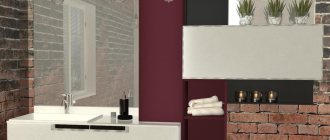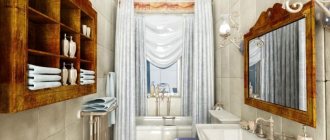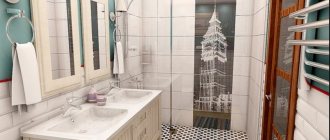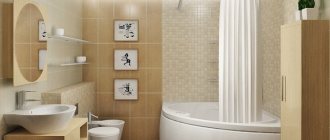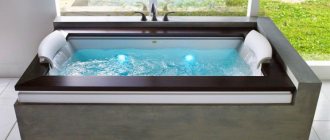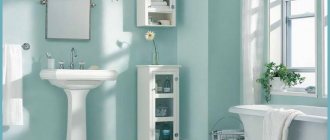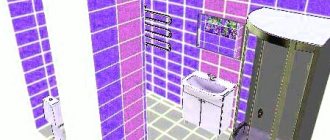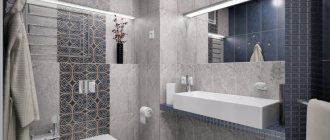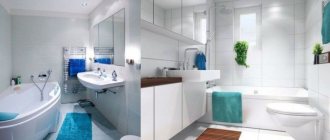The Mediterranean style for the bathroom has become increasingly popular lately. He is fully capable of giving this room all the necessary functions of comfort and relaxation. But in order to decorate a bathroom (or any other) in any particular style, it is important to first clearly understand all its features. So, what is Mediterranean style? It is immediately clear that this is something connected with the sea, and therefore the sun and green plants. And this trio will always create an atmosphere of cheerfulness, calmness, pleasant bliss and tranquility.
If you dig deeper, the style got its name from the Mediterranean Sea, which divides such parts of the world as Europe, Asia and Africa. Accordingly, the founders of this style are Western countries, with opening views of the Mediterranean Sea: Italy, Spain, Greece, Egypt, Turkey, Morocco, Algeria, Libya, Tunisia, France and so on. At that time, simplicity and practicality were valued in the interior. The main feature is the creative approach and the all-consuming comfort of the environment. This style, in fact, is a reflection of the culture, mentality and climatic characteristics of all these beautiful and different countries. So, the Mediterranean is a sunny region with a warm climate, gentle sea and rich vegetation.
Style Features
Handmade furniture is highly prized, usually squat and mainly made of pine or bog oak. If you choose painted furniture, then choose from the shades of the palette of this style. What colors are these? Since the culture of not one country, but several, is used, the tones are correspondingly different. Greece is characterized by cool colors: white, emerald and all shades of blue.
In Italy and Spain, they prefer warm colors: yellow, cream, brick, terracotta, red-pink, ocher-yellow.
This style is also distinguished by the presence of forged interior items, blinds on the windows or light muslin curtains that will flow in graceful waves. The decor can be anything related to the sea: shells, ceramic utensils, sea plants and stones. If you want to focus on the Greek style, then a palette of marine shades will do. For an Italian interior, they choose a juicy earthy color.
All these elements can fit perfectly into the bathroom interior. After all, this room has long changed its status as a “bathroom” to something cozy, beautiful and comfortable. We come to the bathroom not just to wash ourselves, but to relax our soul and body, relax and wash away all worries, worries, stress and the like, both literally and figuratively.
And the Mediterranean interior is perfect for this; it consists entirely of calm and relaxation.
Feeling of peace and cozy comfort
PreviousNext
The main thing…
Since the Mediterranean style implies simplicity, practicality (functionality) and comfort, these qualities will be the basis of the entire room, and this will affect everything. In terms of plumbing, this is expressed in bronze or iron faucets, durable and massive, but most importantly in hidden communications, that is, only the functional part remains visible, for example, the faucet spout, valves to turn the water on and off, and so on. And everything else is hidden behind the trim. This not only looks aesthetically pleasing, but also has a practical approach, because it is much easier to clean up. In addition, it visually enlarges the space and makes it more spacious, which corresponds to the Mediterranean style.
Spanish style bedroom
The Spanish bedroom is characterized by minimalism in details. A large, wide bed is decorated with forged elements. It is covered with a plain brown, red or yellow blanket. The pillows will add a colorful touch. Walls with bare plaster are decorated with classical paintings. On both sides of the bed there are two symmetrical bedside tables made of dark solid wood. Nearby, under one of the free walls, a dressing table made of the same material and a chair with a straight back are placed. The ceiling is also covered with white plaster, which alternates with wooden beams. The interior of the ascetic bedroom is completed by a pair of rectangular mirrors in strict frames on the walls.
Functionality and practicality of a Mediterranean bathtub
PreviousNext
The walls and ceiling can be finished with light ceramics or tiles, which are easy to clean.
Regular tiles are also suitable, but it is better if several color shades are used. For example, an azure-colored mosaic will look great on the walls.
A perfect addition here would be a floor with terracotta tiles.
Furniture is selected using the same principle: a variety of shelves and wall cabinets in blue and/or terracotta colors, wicker baskets. Even towel holders and coat hooks should be in a common style, not necessarily in the same colors, it can be any shade that represents the sea, sky, sun and beach, for example, sand, yellow, orange, turquoise and so on.
It is possible to finish the walls and ceiling with white paint - this is in the spirit of the Mediterranean style of the Greek orientation.
Here the emphasis is on the natural roughness of uneven walls and ceilings, which not only emphasizes the simplicity of the interior, but also saves time, money and effort on leveling surfaces. To create a slant towards Italian and Spanish notes, a combination of several textures is used in wall decoration. This can be decorative plaster, mosaic tiles, imitation frescoes and wall painting.
For flooring, in addition to terracotta tiles, tiles in warm colors are often used: brown, beige, sand, brick, ocher, and so on.
Spanish style kitchen
Spanish kitchens are finished with ceramic tiles or bricks combined with simple plaster. The set can be chosen not only in traditional brown tones, but also in green and olive tones. The furniture must be made of wood. Spanish kitchens are characterized by the use of an island layout. A large, elongated table is placed in the center of the room (closer to the stove), which can serve as a hostess’s workplace, a dining area, and even a bar counter. On the ceiling, traditionally decorated with beams, a group of similar chandeliers is suspended above each functional area. Decorate the kitchenette with brass or copper teapots, ladles, and bowls. A basket of fresh fruit must be placed on the table. Open shelves can be filled with plates and cups, and a set of frying pans can be placed directly on the front panel of the hood.
Warm beach interior
PreviousNext
Although sometimes cold turquoise is used; as well as neutral gray or white.
To add sophistication to the floor, you can decorate it with images of ancient Greek scenes from marble mosaics. Carpets are used extremely rarely as a covering for such floors; mats made of seaweed or reed are more suitable here. They have sufficient strength and a natural aura.
It is important to take into account that neither tiles nor tiles are warm coverings, and fluffy carpets are out of place here, which is normal for Western countries, where the Mediterranean style originated, because the climate there allows the use of such materials. Therefore, the best option for solving this issue in our climate zone would be a heated floor. If this is not possible, then you can use a not very thick carpet of an inconspicuous color so that it does not catch the eye, or it can have patterns in the Mediterranean style. You can also make the floor wooden, but the texture and color of the wood should also not stand out in the overall interior.
Ceramic tiles + mosaic
These two materials are rightfully considered the most common in finishing a Mediterranean bathroom, this can apply to both the floor and walls, and the mirror frame.
Majolica ceramic tiles are often used for decoration; they are done using the technique of underglaze painting. It was already mentioned above that mosaic paintings on the floor and walls are very typical for this style; mosaics can also frame the bathroom screen, the front of cabinets or even the sink countertop. This creates a harmonious and holistic interior. Especially if you use one type of tile, but in different sizes.
Accessories
Waffle towels that match the tone of the overall interior will help emphasize the comfort of the Mediterranean interior. As well as stylized accessories and decor - forged and ceramic, a large mirror dressed in a wooden frame and, of course, green plants. Mosaic objects will perfectly complement the ensemble: soap dishes, glasses for toothbrushes and pastes, flower pots and so on. If it is difficult to find objects decorated with mosaics, you can do it yourself.
Candles in iron or bronze candlesticks can not only convey the spirit of Mediterranean interiors, but also create a truly enchanting and warm environment.
Lighting
Ceiling lamps with elongated frosted glass shades are suitable for lighting a Mediterranean bathroom. But they are not placed along the entire perimeter, but only above those areas that need them: sink, bathtub and mirror. All other areas should remain in the cool twilight. This rule, of course, is not always followed, but this option is the most advantageous and attractive. Although everyone does the lighting in the way that suits them, and this is also correct. For example, a massive or luxurious chandelier is also characteristic of the Mediterranean style. Both chandeliers and spotlights are often used.
Arch is a popular element
In the Mediterranean style, arches are very popular; they give the bathroom a unique charm. Under the dome of the arch, a large mirror and some free space on which you can place candles, potted plants and various stylistic decorative items will look impeccable. In general, smooth lines and curves embody natural grace in the Mediterranean style, which will fill any room with a unique aura of spontaneity and sophistication.
You can also make door and window openings in the form of an arch, round off a wall niche in a unique way, and so on.
Wood in a Mediterranean bathroom
Wooden walls in the bathroom may seem to some to be an attack on antiquity, and even something strange in the Mediterranean style. But! Wood never goes out of fashion, and has always been and will be a source of unity with nature. In this case, wooden walls will also emphasize the warmth of Spanish design. In addition, wood is good both in painted and natural form.
Again, dark wood, such as a wardrobe, wooden blinds or beams on the ceiling, will help to emphasize the Spanish motifs.
So, the Mediterranean bathroom is laconicism, comfort, simplicity and all-consuming peace. This interior is distinguished by natural materials, natural shades, smooth lines, practical and disguised plumbing fixtures, bright and rich colors, elegant but unpretentious accessories, and so on. Everything here is imbued with calm, peace and harmony.
Traditional Spanish furniture - what is it like?
In Spain they use heavy, bulky furniture made of natural wood. No MDF, chipboard, laminated chipboard or other compressed substitutes or imitations, only solid wood. The fronts of the cabinets are only slightly decorated with carvings, without excess. The legs of sofas, armchairs, and chairs also have graceful shapes and neat relief. Soft surfaces are covered with covers or bedspreads in dark colors with discreet patterns. Bed headboards, fireplace grates, decorative parts of shelves and storage systems are decorated with forged elements. In rustic apartments, wicker armchairs and chairs are used. They blend organically into the Spanish style.
How to decipher the markings
Floor coverings are subject to increased requirements for strength; wall tiles are available in a larger range and a wider range of colors.
Spanish wall tiles are produced in various colors.
In order not to make a mistake when choosing ceramic tiles for the bathroom, overpaying for unnecessary indicators, it is important to be able to read the icons on the packaging:
- Hand drawing - material for walls.
- Foot - tiles on the floor, boot with an angle - coefficient of friction on wet lining.
- Foot - flooring, crystal - hardness, gear with PEI - abrasion resistance.
- Snezhinka is a cladding for exterior use with a high frost resistance coefficient.
- The type of firing marked 1 or 2 is indicated by the fire symbol.
- AA – maximum resistance to chemicals (A – low, B and C – medium resistance).
The abbreviation PEI is also found - this is the degree of wear resistance, measured in the range from 1 to 5 units. AA – maximum resistance to chemicals (A – low, B and C – medium). The box also indicates such parameters as thickness and fracture strength, the number of tiles and the area covered by this quantity.
Wall cladding
Bathroom wall tiles should have one important advantage - moisture resistance. Ceramic products have a finely porous structure; therefore, without protective enamel, they easily absorb moisture, expand slightly, and then dry out.
Repulsing water droplets is a good quality for hallway or kitchen walls. In bathrooms, tiles from which water rolls off without lingering on the surface are much more valued. This property will ensure the hygiene of specific rooms for water procedures.
Spanish tiles are suitable for laying in bathrooms because, thanks to their characteristics, they can ensure the hygiene of the premises.
Porcelain tiles (baked clay with iron oxide), if coated with water-repellent enamel, are the best choice for the bathroom. Facing with such material is resistant to mechanical damage and excess moisture.
There are much fewer operational requirements for wall coverings. But it must have high aesthetics and a wide palette.
The interior of the bathroom will largely depend on the choice of color, pattern and combination of different tiles. You can successfully combine tiles of different formats, lay rectangular samples in a herringbone pattern, and square ones in a checkerboard pattern.
One of the options for laying rectangular Spanish tiles is herringbone.
Imitation of natural materials such as wood and bamboo, marble and pebbles sunk into sand is especially loved by designers and consumers. A boring monochrome interior will be transformed by a decorative insert (photopanel or mosaic made from broken tiles with your own hands).
Living room in Spanish style
The living room has a traditional furniture set: a sofa, a coffee table, a couple of armchairs. An organic addition to the decor will be a fireplace, without which not a single Hidalgo house has ever been without. The table is made of wood, the furniture is covered with covers in bright or dark shades. The walls are decorated with large paintings (if the room is spacious), mirrors in wrought iron frames, and the surfaces are decorated with floor lamps with “lush” shades and vases with flowers. The floor must be covered with a rug.
Ceiling
Depending on the chosen style option, the ceiling can be painted or covered with plaster in greenish, blue or white-blue colors - then the Mediterranean style in Greek will be embodied in the bathroom. For Italian decor, the ceiling is finished with slightly rough, uneven textured plaster in warm brown tones.
Snow-white bathroom
An interesting way to draw attention to the ceiling:
- place wooden beams on top of the paint or plaster;
- make a multi-tiered structure from plasterboard and PVC film, decorating it with a stylized ornament.
Ceiling beams in the bathroom
Basic colors ↑
It would seem that the southern regions stand out for their riot of natural colors and richness of shades. However, these colors of life itself were transferred to the decor in a softened version, with a coating of pastel and softness. No wonder. With all their love for the sun, southerners strive for relaxation in dense shade. And the gaze needs calm and rest. In the bathroom, this approach is more than appropriate.
Blue tiles as an identification of marine motifs in the interior. A wicker table with a table lamp creates a feeling of comfort and authentic atmosphere
The classic white color is diluted with various shades, contrasting notes are added, and the sea splashing outside the window is not forgotten. The bathroom seems to be permeated with morning sunlight, in which the following colors appear beautifully:
- olive;
- turquoise, blue (shades of sea wave);
- sand;
- terracotta (a muted version of rich orange or orange).
The national color in the interior is emphasized with the help of ornaments. For example, Greek or Roman motifs are easily recognizable in the design of bathtubs, friezes and other decorative elements. It is not complete without grapevines and olive clusters, traditional for the south of Italy, France, and Spain. Such accents add a special charm to Mediterranean design.
IMPORTANT TO KNOW: Southern style is characterized by bronze or gold elements in the decor.
The highlight of the design is the shutter doors and forged mirror frame. The olive color of the cabinets emphasizes the Italian style
